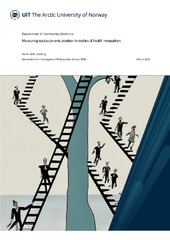Measuring socioeconomic position in studies of health inequalities
Permanent link
https://hdl.handle.net/10037/31868Date
2024-02-08Type
Doctoral thesisDoktorgradsavhandling
Author
Lindberg, Marie HellaAbstract
There is a consistent finding that the higher the socioeconomic position (SEP), the better the health. The choice of SEP indicator is crucial in explaining these socioeconomic inequalities. However, a poorly motivated use of SEP indicators prevails in the literature on social health inequalities, hampering the transparency and comparability across studies. Its primary aim is to explore different ways of measuring SEP to identify social inequalities in health. The thesis focuses on the most common, objective SEP indicators (education, occupation, and income); subjective SEP; and childhood circumstances.
This thesis consists of three papers. Papers I and III apply data from the Tromsø Study, and Paper II is based on an online survey investigating people's views on SEP, conducted in Norway and Australia. Paper I investigates the potential to combine education and income into a composite score for SEP and how it predicts inequalities in health-related quality of life (HRQoL). Paper II assesses the relative importance of objective SEP indicators and childhood circumstances in estimating subjective SEP. Paper III explores the role of circumstances and lifestyle factors in estimating inequalities in HRQoL and self-rated health.
While we found that the combination of education and income demonstrated a non-linear relationship with overall SEP, the composite SEP score was not superior as a predictor of HRQoL compared to including education and income separately. Furthermore, we found that childhood circumstances demonstrated a lasting, independent impact on subjective SEP. Paper III revealed that there were inequalities arising from circumstances, with substantial contributions from financial circumstances in childhood and education.
This thesis demonstrates the need to motivate the choice of SEP indicator in studies of health inequalities. It also stresses the importance of early-life factors as determinants of adult health, advocating for policies targeting childhood circumstances in equalising early life chances.
Et svært vanlig funn på tvers av land, studiepopulasjoner og helseutfall er at desto høyere sosioøkonomisk posisjon (SEP), desto bedre helse. Valg av SEP-indikator som skal reflektere de sosioøkonomiske dimensjonene i helse er avgjørende for å forklare disse helseulikhetene. Likevel er det slik at bruken av SEP-indikatorer i studier om sosial ulikhet i helse ofte preges av svak eller ingen begrunnelse med utgangspunkt i teori og hypoteser, noe som begrenser muligheten til sammenligning mellom studier. Denne avhandlingen bruker ulike tilnærminger for å måle SEP i studier av helseulikhet. Et overordnet formål er å utforske ulike måter å måle sosial posisjon for å identifisere sosiale ulikhet i helse, og hvordan livsstilsfaktorer i tillegg påvirker dette forholdet. Fokuset vil være på de tre vanligste objektive SEP-indikatorene (utdanning, yrke og inntekt); subjektiv SEP; og indikatorer for barndomsforhold.
Avhandlingen består av tre artikler. Artikkel I og III er basert på data fra Tromsøundersøkelsen, mens Artikkel II benytter data fra på en nettbasert spørreundersøkelse om folks betraktninger omkring SEP, som har blitt gjennomført i Norge og Australia. Alle de tre artiklene utforsker bruken av ulike SEP-indikatorer i en helseulikhetssammenheng. Artikkel I undersøker potensialet for å kombinere utdanning og inntekt til en samleindikator for SEP, samt hvordan denne samleindikatoren predikerer helse-relatert livskvalitet (HRQoL). Artikkel II måler objektive SEP-indikatorer (utdanning, yrke og inntekt) og barndomsforholds relative betydning i å estimere subjektiv SEP. Artikkel III utforsker hvordan variabler om barndomsforhold på den ene siden og livsstilsfaktorer på den andre estimerer HRQoL og selvrapportert helse, både på et bestemt tidspunkt og over tid.
Vi fant at kombinasjonen av utdanning og inntekt viste en sterk ikke-lineær sammenheng med total SEP, mens samleindikatoren for SEP viste seg å ikke være bedre i å predikere HRQoL sammenlignet med å inkludere utdanning og inntekt separat. Videre fant vi at barndomsforhold så ut til å ha en vedvarende påvirkning på subjektiv SEP, som var uavhengig av objektiv SEP. Artikkel III viste at det var ulikheter i helse med røtter i barndomsforhold, med særlig påvirkning fra økonomiske forhold i barndommen og egen utdanning.
Denne avhandlingen viser behovet for å gjøre et faglig motivert valg av SEP-indikator i studier av helseulikhet. Den understreker også viktigheten av barndomsforhold som bestemmende faktorer for helseutfall senere i livet, og etterlyser dermed politikk rettet mot tidlige barndomsforhold for å utjevne ulikheter og sikre gode livssjanser.
Has part(s)
Paper I: Lindberg, M.H., Chen, G., Olsen, J.A. & Abelsen, B. (2022). Combining education and income into a socioeconomic position score for use in studies of health inequalities. BMC Public Health, 22, 969. Also available in Munin at https://hdl.handle.net/10037/25264.
Paper II: Lindberg, M.H., Chen, G., Olsen, J.A. & Abelsen, B. (2021). Explaining subjective social status in two countries: The relative importance of education, occupation, income and childhood circumstances. SSM–Population Health, 15, 100864. Also available in Munin at https://hdl.handle.net/10037/22151.
Paper III: Lindberg, M.H., Wildman, J., Abelsen, B. & Olsen, J.A. The lasting impact of circumstances on efforts and health in adulthood. (Submitted manuscript).
Publisher
UiT The Arctic University of NorwayUiT Norges arktiske universitet
Metadata
Show full item recordCollections
The following license file are associated with this item:


 English
English norsk
norsk
